Wayne C. Allen's Blog, page 18
February 15, 2020
Tools for Relating — Having the Best Relationship Ever

Tools for Relating — it’s not enough to have some knowledge about relationships… you need tools and techniques to excel at relating.
Here’s another sample chapter from my relationships book, The. Best. Relationship. Ever. Enjoy!
If you’re looking for a partner that “fits you,” you owe it to yourself to read my book. Find Your Perfect Partner It’s available as a Kindle book here, for $2.99 US.
Two of my other books, This Endless Moment 2nd. edition and Half Asleep in the Buddha Hall, are also available as Kindle books, same price. Those two are also available from Amazon as paperbacks.
The easiest way to check out all of the books is to go to our publishing site, The Phoenix Centre Press.
Last week, I described my book, The. Best. Relationship. Ever.
Here’s The Chapter, “Tools For Relating.” This chapter will give you a good idea of the “meat” of the book.
Chapter Four: Tools for Relating
Elegant, Intimate Relating (EIR)
EIR is a structure for living deeply and fully with others
With EIR, nothing is taken for granted. Elegant, Intimate Relating requires the active participation of two separate and distinct beings, both of whom are dedicated to rigorous self-exploration. Each is using the relationship to gain depth and breadth of knowledge about the only thing each can know: themselves.
Elegant, Intimate Relating is enacted at the direct meeting of two whole persons. I call this “meeting at the boundary” — I am still I, you are still you, and we meet to explore, to reveal, to be open and vulnerable through honest revelation.
The revelation has to be authentic
In EIR, you are choosing to be transparent with your partner. EIR is not about saying nice things, not about manipulating your partner to see or do things your way. Nor is it about hiding the fact that you have a range of feelings and emotions “in there.” Transparent authenticity is choosing to let yourself be seen — as you are, and how you are.
Elegant, Intimate Relating happens only in the Here and Now
It’s not about your stories. Stories, at best, serve as a framework for true vulnerability.
Vulnerability is expressed by letting out what is going on for you, right now, with no excuses. This is me, right now. And part of “me, right now,” is the emotion that is happening inside of me. Not descriptions of the emotions, not blaming someone for the emotions, but rather the emotions themselves.
Once you “get this,” you’ll also notice that emotions are fleeting. I can be sad, then bored, then weepy, then laugh-filled, then have the feeling of “nothing much,” but only if I do not cling to my story, a.k.a. thinking too much.
Being unguarded
Un-guarding yourself means being willing to own and share your in-the-moment reality, without filtering. Being un-guarded means speaking your truth — the truth that comes from “Here is what is so for me”.”
The point of Elegant, Intimate Relating is to clear the decks so that you can shift what is not working. Letting go of guardedness gives us the opportunity to see how we are structuring our stories to stay stuck. From there, you choose to do something new and refreshing. It’s not meant as an exercise in self-aggrandizement, and emphatically is not a game to stay stuck, while pretending to “get it.”
Un-guarding means loosening the filters, and expressing yourself as you are, with focus and clarity.
The Beginning of Elegant, Intimate Relating
The Tools section of the book describes the “how” of an EIR. Here’s the “what.”
Engaged Intimacy, first of all, requires a dialogue agreement
Let me whip out my crystal ball and declare that your past relationship failures were caused by poor, faulty, or non-existent verbal communication. Other problems were: non-verbal communication, magical thinking, lack of physical intimacy, and lack of self-responsibility.
We are going to establish a dialogue agreement, and then discuss how to enact it.
The Dialogue Agreement
“I have decided to commit myself to open, honest, and vulnerable communication. I will use a Communication Model, self-responsible language, and will keep my boundaries open and flexible. I will be in dialogue with you for no less than 30 minutes per day, and when issues cannot be resolved within that time-frame, I agree to make as much time as necessary to resolve the issue, with no compromise. I commit to keep you totally informed about what is going on for me: my stories, my games, my evasions. I will keep you completely informed about my feelings, my attractions, and my other relationships. I do so not for permission, but to facilitate clarity.”
The Physical Contact Agreement
Given that we’re discussing your Primary Relationship, physical contact is a given. We’ve noted that Engaged Intimacy is also available for other relationships. I think it’s important to establish physical parameters, even within the Primary Relationship. Thus:
“I commit to using physical contact as another way of exploring my emotions, blockages, and my connection with you. I accept that physical contact is an end unto itself — that it is not primarily a means to having sex. I will be open and honest about my need for emotional expression, and will use safe methods of expressing my emotions thoroughly. I will ask for what I want as regards physical contact, recognizing that what I want “now,” may not be what I want “later.” I will invite Bodywork pressure on “stuck” parts of my body, and offer to do the same for you. I am open to expressing whatever feelings arise through physical contact, will stay focussed on myself, and will feel my feelings fully.”
This becomes the framework for Engaged Intimacy
From this baseline, which you are free to add to, but not reduce, we begin the process of building intimacy and presence. I would suggest that you look carefully at the above Agreements, and then read through the “Tools” chapters to follow. Once you have a grasp on how this all fits together, sit with your partner, begin right here with the Agreements, and structure your own agreements.
You will want to write out what you are agreeing to, and then sign it. Remember: all you can agree to is what you will do. This is not a conditional, “If you do this, then I’ll do that” kind of agreement. You are making the commitment to yourself to act in a certain way, while in your partner’s presence. I’ll be reminding you of that as we go along.
The 9 Tools
The Structure
It is our belief that self-knowing happens best in your Primary Relationship. This relationship has as its keys: elegant communication, vulnerability, (the willingness to open up) openness, (the willingness to take in) and intimacy (making full, honest contact.)
Through dialogue, baseline parameters are set, in the following two areas:
Engaged Communication — this is the minimum requirement — that there be open, honest, and intimate dialogue. We propose following the basic Communication Model described below — using it to dig deeply, and learn more of both “self” and “partner.”
Engaged Contact — after the above is established, the couple creates levels of physical contact. It’s essential to create flexible boundaries in this area, and to immediately discuss areas of confusion / discomfort.
Within the “safe hands” of Engaged Intimate, Relating anything is possible. We have the opportunity to trust, to open, to be vulnerable, and especially, to explore our own darkness, in the presence of a partner who is a curious, active participant.
The following 9 Tools form the basis for what is to follow — we believe that this is the only way to achieve personal and relational contentment!
As I noted earlier, this book is seemingly about relationships, but it’s actually a self-development book. Self-work is the only way to engage with life, with others, and with our way of being. Our relationships shift precisely as much as we, as individuals, shift.
What follows are brief descriptions of the 9 Tools
I’ll flesh them out in later chapters of this book. For now, let me suggest some understandings for each of these points, and how each applies to personal living and Elegant, Intimate Relating.
1. Total Honesty
It’s impossible to have a rich and meaningful relationship while keeping secrets (“The flaw of omission,”) or while lying (“The flaw of commission.”)
Many are the excuses for dishonesty:
~ “I’m an adult and I have a right to privacy.”
~”(S)he might get mad if I was honest about everything.”
~ “I just want to be me — no need to talk about it.”
~ “White lies aren’t harmful.”
Being dishonest is a mini-betrayal. It’s an indicator that you don’t trust your partner enough to share what’s up for you, and are embarrassed about your actions.
We advocate Total Honesty. And yes, sometimes being totally honest is scary, or might lead to a protracted discussion. But the truth is this: almost everyone who lies gets caught.
Personal: “It is my intention to tell the truth, all the time. I recognize that how “deeply I go” depends on who I’m interacting with, but I will answer truthfully, and be direct and clear with everyone.”
Relational: “From this point on, my policy with you is Total Honesty. I’ll let you know what I am thinking, how I am deciding, and what I am doing. I am not doing this for permission, but rather to foster intimacy and deepen our relationship.”
2. Being Present
Presence is about 2 things:
~ being in the moment, the Now, and
~ being focussed on what you are doing.
Most of us live our lives either in our heads (story-telling), or detached from our selves (numb.) Sort of ghosts, walking.
Being in the Now helps us to stay focussed on the immediate situation, while adding little or no drama through storytelling or future projections. This kind of presence allows us to deal with each situation as it occurs.
Personal: “I just tuned out and ended up imagining all kinds of stories that have nothing to do with the situation before me. I’ll just have a breath and come back to the present moment.”
Relational: “As I listened to you, I caught myself telling myself familiar stories about how hard-done-by I am. I recognize that my stories have nothing to do with you or the situation, so I’m filling you in as a way to come back to the Here and Now.”
3. Being self-responsible
Self-responsibility is not about self-blame. Rather, it’s about claiming ownership of our lives.
It is ‘normal’ to push responsibility away. Most are willing to take credit for success, and want to point a finger elsewhere when confronted with things judged ‘wrong’ or ‘bad.’
Self-responsibility is simple — “I am the author of all of my life, as I view it right now.” This is not a denial that ‘bad’ things happen,” and that others may even intend us harm. It’s to say that nothing compels us to act in ways that are non-helpful.
Personal: “This is going on right now, and I am making myself uncomfortable. Nevertheless, I am in this situation because of my choices. I can, at any time, choose differently.”
Relational: “I am upsetting myself over the way I perceive our relationship. Therefore, I will own my responsibility for having gotten myself into the state I am in, and I will decide what I will do next.”
4. Speaking clearly — Use dialogue to know yourself
We teach a specific Communication Model, and do so because most people are lousy communicators. Rather than use communication to deepen their self-understanding, they use it to justify their “hardened” behaviour and thinking, while proving others wrong. Or, they use communication to blame.
As soon as you harden a thought into a belief, you become “unteachable.”
Dialogue, on the other hand, is about exploring our personal beliefs as we listen to feedback. It is essential to bear in mind that this exploration is only possible if you choose to hold your beliefs and “demands” loosely.
Personal: “Here is what I see, here is what I feel in my body, and here are the stories I am telling myself.”
Relational: “I want to share with you my provisional guesses about what I see happening right now. I’m wondering about your perspectives on my stories.”
5. Being Curious — and NODing
When we live our lives up in our heads, dwelling on the past and fearing the future, we think that our version of misery is reality. We get locked into thought-loops. We exit the moment, shut down by tightening our bodies, and dwell in “Never-Never Land.” The “Never” part is actually, “My life will never be different, and I’ll never be able to change.”
Curiosity is the opposite of self-righteousness and blame. If you pay attention, you’ll notice that you are often confused about your own motivations and actions. How then, could you ever think you had a clue about what’s up for others?
Personal: “I am drifting into past and future again. What is actually happening right now? Is anything required of me, right now? What does my body want to do? What would happen if I stopped telling myself stores, sat down, and had a breath?”
Relational: “When I confront situations like this one, I get caught in a mind loop… I’m wondering if you would have time to listen to my description, and then I’d like to hear about how you get yourself out of your mind-loops.”
6. Letting go of Drama and Storytelling
Obviously, we have a story about ourselves — one we are anxious to tell others, and one we believe is ‘true.’ The story contains fragments of our biography, and mostly consists of examples that support our victim-story. One of the great leaps of self-responsibility is the understanding that our stories are “just stories.”
We have much invested in our life-story, and also give much energy to defending everything that props it up. We move past this by allowing ourselves to question both the accuracy and validity of the stories we are telling.
Letting go of drama is similar. Because we spend so much time talking to ourselves, about ourselves, we have a tendency to see ourselves as the centre of everything. Now, certainly, we are the centre of our own universe and experience — we’re just not the centre of anything else. Despite our desire, no one is going to make us the centre of their universe. And the stuff that happens is the stuff that happens. It’s not happening to you personally.
Personal: “Here is what is actually happening right now. I notice the story I’m struggling to tell, where I’m a poor, helpless victim, and I choose, this time, in this moment, to let that story go. In this moment, I’ll be present and aware, and see what, if anything, is required of me.”
Relational: “So, I notice that I’m hearing you speak, and I’m seeing what you’re doing, and I’m telling myself all kinds of stories about how you are punishing me, or trying to manipulate me. I notice that I am creating these stories out of my thought-loops, and I want to acknowledge that I’m doing this. I will now let go, and return to being open and curious.”
7. Being Flexible
The lynch-pin for Elegant, Intimate Relating is flexibility.
I may have spent years developing my relating style, but I also have the power, each time, to change what I am doing.
Integrity plays a big part here
While I know that I have complete freedom of expression, I also begin to look at the consequences (results) of my actions. I evaluate the result I am getting against what I have committed to — Elegant, Intimate Relating — and only do what deepens my relating.
This is flexibility
Personal: “Here I go again, doing the very things that endlessly land me in the soup. This is who I am, but right now, I can transform this pattern by stopping, having a breath, and making another choice.”
Relational: “Wow, there I go again, blaming you for how I am feeling. I accept that I do this, and am pleasing myself that I caught myself this time. Give me a second to have a breath, and then I’ll shift back to dialogue.”
8. Feeling Your Feelings
Feelings have a bad reputation. People resist their ‘negative’ feelings — are caught in judgement — endlessly assigning “good / bad, right / wrong” categories to everything.
Essential to Elegant, Intimate Relating is total acceptance of each and every feeling
As we meditate, for example, what becomes clear is that thoughts and feelings flow through us like clouds crossing the sky. If we latch on to the feeling / thought, we create suffering for ourselves. If we express the thought or feeling, we can let it go.
There are no ‘bad’ feelings — there are, however, non-useful ways to express them. So, we accept and transform each feeling by expressing it with awareness.
Personal: “I am aware of my anger, my boredom, my sexuality and sensuality, my tightness, my shutting down — all of my feelings. I accept that these feelings pass through me — they are not me, but rather expressions of my moment-by-moment experience. I therefore choose to express them safely and thoroughly.”
Relational: “I’m noticing that [the current feelings] are coming up for me, and I’m wondering if you’d be interested in helping me to fully experience and express them, so that I can learn their lesson and then move on to whatever is next.”
9. Exploring Sensuality and Sexuality
Most adults have “issues” around open, honest, and deep revelation and expression of matters sexual. The discomfort is deep-seated — stretching back to childhood.
Because of our discomfort, we talk in euphemisms and hints. We tend to only get part of what we are looking for, and might be unclear about what we want.
We also have desires and attractions for others, and are uncomfortable both with the feelings themselves, and with sharing them. We avoid conversions about our “turn-ons,” out of confusion, fear, and to avoid jealousy. We end up more confused, blocked, and wary.
Personal: “I am doing some serious work exploring my sensual and sexual nature. I am going to use clear language to describe who I am and what I want sexually, and I am going to create “Vulnerability Projects” to explore areas I am curious about / scare myself over.”
Relational: “I am noticing that I have some issues as regards my sensuality / sexuality. I am exploring these issues, and I will keep you informed about what I am discovering, as well as invite you to work on some of this with me. I also commit to keeping you updated on people I am relating with, and letting you know who I find attractive, chargy, etc.”
Let’s see how this all plays out.
February 5, 2020
Having the Best Relationship Ever
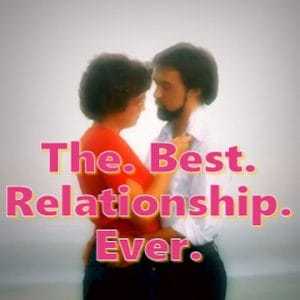
Having the Best Relationship Ever — a look at what’s behind my book, The. Best. Relationship. Ever.

Psst!! Hey!!!
Want more great writing designed to help YOU to shift your behaviour?
Want to learn how to find, build or deepen your principal relationship?Want to know more about Zen living and being?Want to learn how to find, build or deepen your principal relationship?
Check out Wayne’s books!!!
Back when I was in private practice, three topics came up… a lot:
stuff about passion, vocation, sexualitystuff related to getting your life together, andstuff about relationships
There’s a lot of bad information out there. I wanted to help more people… so I wrote books!
After writing three books geared toward individuals, I wrote two about relationships.
First, I wrote a greatly expanded version of my booklet, the List of 50. This book is a methodology to figure out how to, as the title says, “Find Your Perfect Partner.” The concept is simple. Hormones do a lousy job of helping us to pick someone to date.
Thinking through (which is a component in “getting your life together”) who you want to be in relationship with is the only way to get what you want.
But finding a great partner is only “Step 1. ” The rest of it happens as we practice, day in and day out, the fine art of relating.
Many years ago, I started writing a relationships book. It’s had various names, and was an odd book.
I’m usually OK with writing and finishing up, but this one was slippery… it kept getting longer and longer, and I couldn’t figure out how to end it.
I think this was because I really believe in the value of an excellent relationship.
And that meant I wanted to get the book exactly right. I realized how much trouble I’d had getting to the place of knowing what works and how to do it…
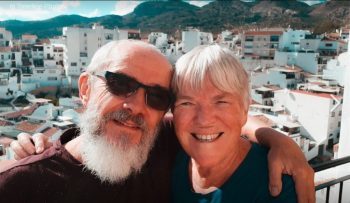 The Darbella and Wayne show
The Darbella and Wayne showNo question, hanging out with Darbella for almost 40 years now has been “interesting.” I really did have a lot of baggage back in 1982, when we got together.
This would include 2 failed marriages, and an ego that filled rooms. (I’ve got it down to closet size. Really.)
Dar was patient, and crystal clear about not playing my games. I learned to focus on me, and me alone — as in, not blaming her for any part of my internal experience.
That was the turning point for me: I accepted 100% responsibility for my life
As I mentioned above, this led to my first 3 books books, This Endless Moment, Half Asleep in the Buddha Hall, and. Living Life in Growing Orbits… which are focussed on individual exploration.
But that relationships book… that was another story.
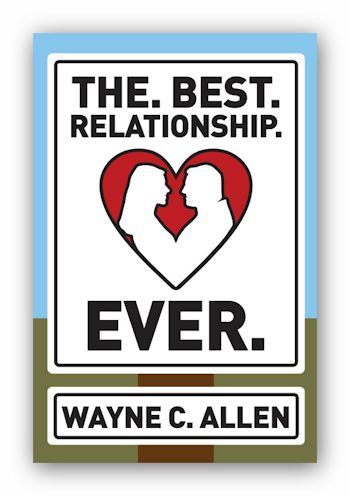
Anyway, I got a lot of requests from my clients for a relationships book. I decided that I needed to “get ‘er done,” so I worked through several stored and dropped versions, looking for the meat of the book.
I found it
The. Best. Relationship. Ever. is a guide to what works. I’ve included details on the Communication Model, as well as 8 other Tools for Relating.
I devised exercises and a plan for working through the Tools to create a relationship that works.
Here’s the Introduction
First of all, welcome!
My wife Darbella (Dar for short) and I have been developing and teaching Elegant, Intimate Relating since we met in 1982. We’ve helped hundreds of clients to strengthen and deepen their relationships. Needless to say, what you’re about to read is the bedrock for our own relationship.
We’d like to help you — if you use what we’ve learned, and your relationship will become the best is can be.
Over the years, I’ve written two booklets about relating, as well as creating “The List of 50,” — a method to figure out what you want in a partner (expanded to a full length book, Find Your Perfect Partner.) Recently, I decided it was time for a practical guide based on Elegant, Intimate Relating.
The. Best. Relationship. Ever. teaches the nuts and bolts of building and maintaining a great relationship. You’ll learn about what Elegant, Intimate Relating looks like, you’ll discover how to communicate with clarity and curiosity, and you’ll discover how to continue deepening your relationship over time.
The Plot Thickens
The best gift you can give yourself, right now, is an acknowledgment — you really don’t have a clue what it takes to have a full-bodied, lush relationship, now do you??
And really, why would you? They’re pretty rare. Most experts, including me
January 27, 2020
The Power of Wise Intention
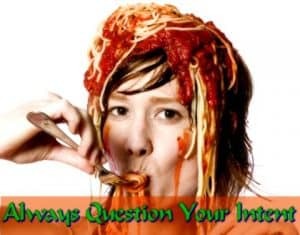
Wise Intention is the bedrock of both elegant communication and grounded living.
This topic is addressed in two of my books, Half Asleep in the Buddha Hall and The. Best. Relationship. Ever.

Psst!! Hey!!!
Want more great writing designed to help YOU to shift your behaviour?
Want to learn how to find, build or deepen your principal relationship?Want to know more about Zen living and being?Want to learn how to find, build or deepen your principal relationship?
Check out Wayne’s books!!!
I want to give a shout out to Lion’s Roar, and to the article How to Practice Wise Intention, written by Sylvia Boorstein.
So, what exactly is wise intention and why would I want some?
To put this in context, in Buddhism The Four Noble Truths, or perhaps more clearly, the 4 Preeminent Realities, are the 4 Descriptors of the way it is.
You can read about this in Half Asleep in the Buddha Hall, but the gist is that we realize, endlessly, the unsatisfactoriness of the life we create, and we try to cling to what we judge is good while resisting what we judge to be bad.
The way out, we learn:
…of this cycle is through cessation (nirodha). If I stop desiring, (through the disciplining and emptying of the mind) and live in the Now (because desire is always about wanting (or avoiding) what I had in the past, or wanting (or avoiding) something in the future), my sense of unsatisfactoriness (suffering) will cease.
The cure proposed by the Buddha, is magga—the Eightfold Path of ‘sound living, one of which is “wise intention.”
On the “western side,” there are a couple of really popular communication models, and they feature 5 elements: perception, feeling, interpretation, intention, and action.

I guess wise intention is important!
January 20, 2020
Dropping Arrogance
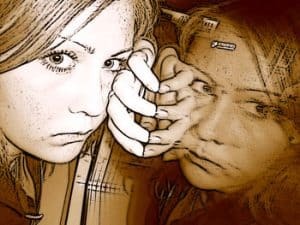
Today, we’re using a familiar Zen story to help us to see ways for dropping arrogance
This topic is described in my book, Half Asleep in the Buddha Hall. You can read more about it here

Psst! Hey!
** Want more great writing designed to help YOU to shift your behaviour?
** Want to learn how to find, build or deepen your principal relationship?
** Want to know more about Zen living and being?
A Few Ways to Get Over Yourself
This is a Zen story about Today, we’re using a familiar Zen story about dropping arrogance that most people know:
On the surface, this is a simple story. The scholar thinks he knows something, and is therefore unteachable. Yet, this is entirely too simple an explanation.
A scholar went to visit a Zen Teacher. The Zen Teacher offered the scholar some tea. While it was brewing the scholar began to expound on all that he knew, what he had done, and how brilliant he was.
The Zen Teacher made tea.
The scholar continued blathering on. The Zen Teacher handed him a teacup and began pouring. He poured and he poured, eventually filling the cup, then overflowing it.
The scholar yelped, “It is overfull. No more will go in!”
“Like this cup,” the Zen Teacher said, “you are full of your own opinions and speculations. How can I show you Zen unless you first empty your cup?”
Speaking of dropping arrogance, I saw the opposite enacted at the Buffalo Zen Center. There were a couple of guys there, in their 20s, who said that they’d studied Zen and Buddhism for a while and had not been able to find peace and a calm center.
They thought that some zazen (sitting meditation) might help.
They then spent better than an hour telling everyone all the things they’d done in Japan, Korea, etc., about all they’d studied, about all they knew.
Except they had started the conversation by saying that nothing they had learned actually worked!
I used to see this in therapy all the time — people told me what was wrong — what wasn’t working, what wasn’t happening in their relationship, and then they’d blame their partner! Then they’d try to persuade me to teach them how to make their partner behave.
The thought that they just might be clueless eluded them.
My job is never to persuade someone that I am right and they are wrong. My job is to help them to notice how full of themselves, and how full of their arrogant assumptions, they are.
My job, if you will, is to hand them a pitchfork and point them to their internal manure pile.
In Buddhism in general and in Zen in particular, there is great emphasis on “emptiness.”
The Zen teacher in the above story is not suggesting that the scholar empty himself of his own judgments, understandings and thoughts — so that the Zen teacher can fill him up with his. That would be silly.
Most think this way, though. People endlessly seek the right answer, the correct answer, the final answer. It’s as if they think that one size fits all. Western thinking and education promotes this idea.
Uncertainty, for most, is uncomfortable.
Our problem is exactly the one faced by the scholar. He knew a lot. He had filled his head with learning. So, in keeping with what he knew, he showed up on the Zen teacher’s doorstep, looking both to show off, and to cram in more learning.
His learning had gotten him nowhere in terms of his personal life satisfaction and focus, so he decided to do more of what had never worked.
Now, this is not a condemnation of learning. I’ve got a couple of Masters Degrees myself, and I consider myself to be pretty smart.
What I do know is that all of my intelligence has never helped me understand myself, or others. What it has done is given me the ability to argue, fight, and try to prove others wrong.
A load of intelligence is a dangerous thing.
Emptying oneself, dropping arrogance… is scary. I remember my therapist telling me to “Spend 6 months not knowing.” I really freaked out over that one. I wasn’t sure how to approach life in a state of “not knowing.”
What I’ve come to understand is that, even in “not knowing,” a part of me does know. I know what’s up for most people, and I know what’s up for me, most of the time, and with fair accuracy.
What I’ve realized is that knowing something doesn’t change anything.
What I mean is, I might have an insight about myself or another, and it might even be accurate. The other person, upon hearing it, might respond, “Yes! That’s exactly what’s up for me!”
Now, from an ego perspective, I might get quite full of myself and congratulate myself for my wisdom and insight. The problem is this.
Knowing what I know, and stating it, has no effect on the actual situation .
My perceptions, insights and intelligence are only about me. When, for example, I write something about Darbella, I am not describing her. I am describing my version of the Darbella story I have in my head.
So, you learn about me, not about her.
Emptiness requires that I let go of clinging to my beliefs — or better, to the rightness of my beliefs.
Emptiness requires that I understand that how I see the world is how I see the world, and nothing more. Emptiness is letting go of the need to get others to agree with me. Emptiness is living in the ambiguity of knowing without knowing.
As soon as I think you need to change something so I can be happy, I am in deep trouble. Emptiness is this: I can let go of thinking that the world is supposed to co-operate in a “make me happy by agreeing with me” project.
I can let go of thinking I have all the answers, I can let go of valuing my judgments (instead, I can just have them), and be open to perceiving the situation at hand, while noticing my filters, prejudices, or pat solutions.
Tall order, dropping arrogance.
The Zen Teacher offered the scholar something precious — compassionate dialogue. In order to thus engage with someone, I have to be willing to suspend my ego-driven search for the right answer.
Most people waste their lives in search of this elusive ideal — the right partner, the right religion or belief (philosophical) system (actually the same thing…) the right political party, the right approach to self and others.
At the end of the day, all I can know is how I choose to act in this moment.
The Zen Teacher and the scholar met over tea, and in that moment, each had the opportunity to open up by letting go. Each had something of himself to share; each had something to hear and to learn of the other.0
The scholar blocked his side of the opportunity by presenting what he knew, as opposed to letting the Teacher see who he was, in that moment.
The Teacher did not blame, criticize or judge. He poured tea, and when asked, explained his actions, without rancour or judgment.
Letting go of the stories we hide behind is the work of a lifetime. Trust and patience are required. And openness.
January 5, 2020
Learning to be Ordinary
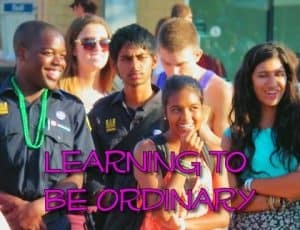
Learning to be Ordinary — being ordinary is not boring. It’s using our selves fully, without comparison to others. It’s being present and content, without comparison.
This topic is described in my book, Half Asleep in the Buddha Hall. You can read more about it here

Psst! Hey!
** Want more great writing designed to help YOU to shift your behaviour?
** Want to learn how to find, build or deepen your principal relationship?
** Want to know more about Zen living and being?
So, have you ever heard of “Placeholder Theory”? As I listen as friends try to come up with the meaning of their lives, I often hear some version of it.
In Zen, another way of looking at “things” happens as we explore the interplay of “light / darkness.” For example, in The Blue Cliff Record, we read,
Yun Men imparted some words saying, “Everyone has a light; when you look at it, you don’t see it and it’s dark and dim. What is everybody’s light?”
~~~~Yun Men
He himself answered on their behalf, “The kitchen pantry and the main gate.” He also said, “A good thing isn’t as good as nothing.”
The universal problem is this: there are two simultaneous realities (you can call them light and dark, as above.) In one reality I exist (and things exist) as unique and special. In the other reality, everything just “is.”
The other day, a friend told me about a book she’s reading, and the book’s premise is that we design our lives, point by point, before we’re born. We even create “choice points,” where the road forks depending on what we do.
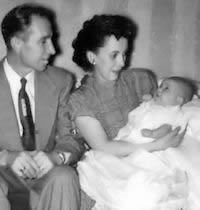
My baptism
“Can we send him back?”
“No, I think we’re stuck with him…”
Apparently, all of this starts when we choose our parents. Yeah.… Right…
“Really? But… what if my parents chose me, when they were designing their life?” Or, what if “I” got chosen by more than one set of parents? Did they fight it out? And if I chose my parents, did they get to say no, or were they stuck with me?
I suspect they were stuck with me, because the whole system depends on “me” being the “real, important person,” while everyone else on the planet has somehow agreed to be a bit player in my drama.
And, of course, this means that my friend is also a bit player in my life. And my friend has kids, so doesn’t that mean she was chosen to play a role in their lives, and therefore is a bit player there, too?
Another version of this weirdness is called The Placeholder Theory
The Placeholder Theory comes from parking spaces, and is something I’ve heard a million variations of — sometimes in jest, but usually semi-seriously.
I’ll give you a common illustration, and then we’ll spend a little time exploring the theory’s uses and abuses.
Here’s the theory: some people serve as placeholders for others.
There is the primary person, (I chose my parents!”) and the bit players, who provide experiences the primary person needs in order to learn.
 I’ll just stand here ’til you’re ready to take my place…”
I’ll just stand here ’til you’re ready to take my place…”Here, finally!, is an example: Emma Entitlement is late for a meeting. So she puts out “a vibe,” (prayer, intention, whatever) and as she approaches her destination, someone (the placeholder) backs out of a parking space right in front of her destination.
I’ve heard this story (and specifically the parking spot version) from many people.
What I’ve never heard is someone “owning” the placeholder role: “Yeah, I was going to leave the parking lot, and then I got this vibe that I should wait a bit. When I did pull out of the parking space, I looked in the rear view mirror, and the guy who took the spot — boy was he looking pleased! I’m so glad I could be his placeholder, even if it meant I was late for work!!”
In other words, most folk resist the idea that they are in the placeholder role for others.
I call this the arrogance of the quasi-wise.
We who profess to “get it” are often caught in our delusions.
And one of the biggest delusions is the idea that “getting it” means we are special. That we are here to learn, and others are here to support our learning. That our role is to “make a difference” that others will notice and admire.
We really believe that we have been working hard to get here (wherever “here” is”) and we rebel at the notion that our role is placeholder for someone who “gets” more than we do.
Here’s the problem: If I think that others are placeholders for me, and you think others are placeholders for you, then we all need to look in the rear view mirror the next time we exit a parking slot, just to catch a glimpse of who we are place-holding for!
Because you can’t have one without the other. It has to work both ways.
This is the point of the Blue Cliff Record I mentioned above. Light, in this case, is similar to “getting it.” The question is, what are you hooked on?”
What I mean is, if you think you “get it,” or are “getting it,” you are hooked on the idea of how special you are. “See!!! I get it!!! I’ve done the work!!! I see the light!!!”
Except, en-light-enment (Learning to be Ordinary) is not special. It’s right here, right now, and it is all about simple presence. As soon as you think it, or you, is special, the light goes poof, and you’re lost.
The light is the kitchen and the gate. It’s everything and everyone (even Trump! Yikes!) As soon as I have an opinion about it, the light goes poof. Thus, “A good thing isn’t as good as nothing.”
If I create an enlightenment scale and place myself on it, there are always going to be people “further along.” So long as I’m looking “down” on others, I can feel “special.” But as soon as I look “up — ” Yikes!
The way out is Learning to be Ordinary — the ordinariness of simple presence and being.
 The walk into ordinariness
The walk into ordinarinessLearning to be Ordinary is “just getting on with it.” Doing what I do because that is what I do. Learning what I learn because that’s the lesson I choose. It’s understanding that far from being an up / down system, life is a balanced ecology.
I depend on you, you depend on me, and actually, we are, at our core, the same entity.
We’re all in this together, and “special,” “secret learnings and paths,” placeholders — it’s all a game to futz with the reality that we are here to get over ourselves, and to get on with what we choose to focus on.
Ram Dass used to say that his process was, “nobody special training.” And then he’d talk about getting caught in his ego, and using his “guru status” to get all kinds of special favours. (“Want to come up to my room and see my holy pictures?”)
He told these stories with a rueful smile, as getting caught in this game is a part of the human condition. The real game is to wake up enough to notice the gme you are playing, and then… to choose another way. Because “A good thing isn’t as good as nothing.”
I wrote about my own games and evasions in my book, This Endless Moment, in the chapter on Deconstruction. Being “The Minister!” got me all kinds of perks, until I couldn’t sustain the game.
Learning to be Ordinary equals “Having a sole focus on presence during the walk of life.”
The real reason therapy (any therapy) works (when it works) is that the therapist and the client are fully present with each other. It is much more so the presence as opposed to the technique. In presence, we can drop our stories and evasions, work on what hurts, and let go of specialness.
If I am present and focussed, then there are no ups and downs, no better or worse, no right or wrong, no clean and dirty. There are no placeholders, because there is no difference between me and not me. It is as if the stuff of the universe is everywhere, and appears in different, unique forms, but is always what it is at its essence.
Sounds pretty mystical, right?
Nonetheless, it is the nature of the universe, down to its core. Light and dark, dancing.
There is no real satisfaction from thinking, “I am better than ‘Joe’ and worse than ‘Sally.’ ” Oue egos desperately want us to play that game, and much of life is wasted on comparisons, but to use a contemporary experience, “In a fire-storm, everyone is equal.”
Nature is there to remind us that the cosmos really does not play favourites. We live in an essentially neutral universe. We all put our pants on one leg at a time, all are born and die alone.
We are on the walk until we aren’t. The quantity of the days of our lives is totally out of our hands. Ah, but the “quality” — that’s another story.
Yet, because each of us has to continually deal with our sense of specialness (entitlement, the ego voice screaming in our heads, whatever) we get caught in inertia — some variant of either helplessness, or stomping our feet and saying “It’s not fair,” or looking for rescue — are common.
Whenever I find myself in that place, I remind myself of a Zen story.
A man goes up the mountain, looking for the Master. After 6 months of looking he’s about to give up. He sees an old man coming down the hill, carrying a bundle of firewood on his back. He asks the old man if he is the Master.
The old man nods.
The seeker says, “What is Enlightenment?”
The old man drops the wood and says “Ahhh!”
The seeker is instantly enlightened.
Then he asks, “What comes after Enlightenment?”
The old Master bends, picks up the wood bundle, and continues down the hill.
This story is expanded upon in my book, Half Asleep in the Buddha Hall
What comes next? Living. Until we aren’t.
Learning. Growing. Understanding.
It’s enough.
December 29, 2019
The Straightjacket of Delusion
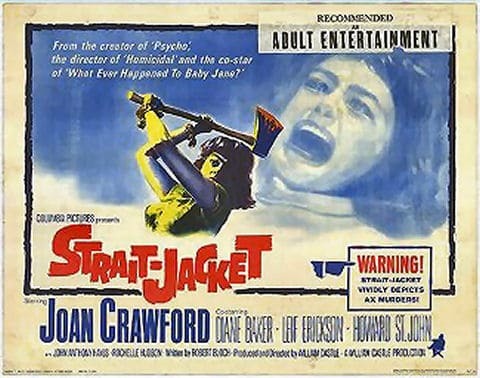
What’s Your Problem, Man?
This topic is described in my book, Half Asleep in the Buddha Hall You can read more about it here

Psst! Hey!
** Want more great writing designed to help YOU to shift your behaviour?
** Want to learn how to find, build or deepen your principal relationship?
** Want to know more about Zen living and being?
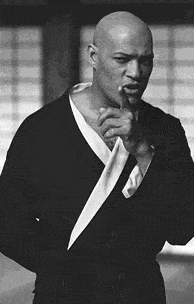
One of the main plot points in the movie series “The Matrix” is that what people are seeing is an illusion. — and this is a key tenet in Buddhism.
In the Matrix, the illusion is done on a grand scale — humans are food, are confined to cylinders, and are drugged into thinking they are actually living in an apparently “real,” yet totally fabricated universe.
Morpheus, the guru to protagonist Neo, is sort of a guide cum mentor cum martial arts trainer. A human Yoda, as it were.
He offers Neo a choice:
Morpheus: This is your last chance. After this, there is no turning back. You take the blue pill — the story ends, you wake up in your bed, and believe whatever you want to believe. You take the red pill — you stay in Wonderland, and I show you how deep the rabbit-hole goes.
And believe me, that rabbit hole is deeper than is easily imaginable
Morpheus:Let me tell you why you’re here. You’re here because you know something. What you know you can’t explain, but you feel it. You’ve felt it your entire life, that there’s something wrong with the world. You don’t know what it is, but it’s there, like a splinter in your mind, driving you mad. It is this feeling that has brought you to me. Do you know what I’m talking about?
Much of what I’ve written, and the way I attempt (and often fail) to live my life has to do with escaping the straight-jacket of delusion. The delusion comes in many flavours, and has everything to do with thinking. Analyzing. Judging.
And, emphatically, it has to do with escaping how we act. You know, things like looking outside of yourself for success, happiness, fulfillment, and approval. Or even more problematic: looking outside of yourself for rescue.
The truth of the matter is that all of us have been fed a line about what the world is about — about how the world works. This imaginary dream-world was described in the Story of Indra’s Net, millennia ago. (I write about this story in my book, Half Asleep in the Buddha Hall.)
Morpheus: Have you ever had a dream, Neo, that you were so sure was real? What if you were unable to wake from that dream? How would you know the difference between the dream world and the real world?
“Blue pill reality” = the story society teaches you — has been, and continues to be, handed to you on a platter.
It’s the fantasy that the world is (for everyone but you) wired to provide for your every desire, that others are supposed to do what you want them to, and that life is supposed to be (or make you) happy.
 If only… my cami was green,
then
I’d be happy
If only… my cami was green,
then
I’d be happyThe kind of happiness being sold is of the materialistic sort. It’s dependent happiness — if I have the right job, take the right course, have the right parents/spouse/kids, if I make the right amount of money, and live in the right town, in the right size house, then I’ll be happy.
Except that, even as some or all of those fantasies come true, all that happens is that happiness recedes, as new “demands on the universe” occur to you.
Along with the “happiness is everything” mantra comes its partner — grasping.
Because the stuff you want seems fleeting, you cling to what you have. Because some other stuff seems “yucky,” you endlessly push it away, yet find yourself endlessly pushing.
And the biggest grasping of all is the belief that the way you think the world is, has anything to do with how the world is.
At the same time, there’s that little voice, whispering that something about your picture of the world isn’t quite right. Yet, when a solution(such as meditation,) is offered, that’s when the excuses come out.
People are quite content to stay stuck in the Matrix, desperately doing what they can to ignore the pain of knowing something’s amiss.
That’s the splinter in the mind part of the above quote.
It’s the niggling, poking, irritating “knowing” that something about this picture is haywire — that something about what we’ve built out there, the way we live, the way we relate, the way we make a living, that all of it is somehow “half a bubble off plumb.”
In the middle of the 19th century, the existentialist philosopher Kierkegaard first described this splinter as Angst. More than anxiety, Angst is a deep seated and profound despair and insecurity. In a sense, the baubles and allures of modern life are sold to us as a distraction from this Angst-driven splinter of suspicion.
The path we suggest is finding your freedom. It is not freedom from. It is, symbolically, popping the red pill.
I tend to frame this from a Zen perspective. I do this because I am continually amazed at the insights of The Buddha, so many centuries ago, as he saw through the illusion and delusion of living life from a perspective of dualism. He identified the essence of life — clear, unencumbered, liberated understanding.
He freed himself from the paralysis of analysis, stopped over-thinking, and began to live.
He saw through the delusions that surrounded him, dropped the endless search for happiness, and found Nirvana (peace.)
It was not Siddhartha’s aim to be happy. His path does not ultimately lead to happiness. Instead it is a direct route to freedom from suffering, freedom from delusion and confusion. Thus Nirvana is neither happiness nor unhappiness–it goes beyond such dualistic concepts. Nirvana is peace.
What Makes You Not a Buddhist, pg. 87?
Here’s a hint: if this splinter analogy makes sense to you, if you “get” that something is wrong with the traditional picture of who you are and how the world works, then — wait for it — you must step out, completely, from the faulty picture, and embrace another way.
Half measures do not work.
Dabbling at meditation, trying a communication model, experimenting with Qi Gong, testing out a therapy — all are ways to stay deeply caught in the Matrix, while lying to yourself that you are actually accomplishing something.
Half measures do not work, and are actually a part of staying deeply stuck.
But, but…
But nothing. The splinter feeling is there, for all of us, because the common, “blue pill” version of the world simply does not hold. The cosmos is not a celestial candy store, just filled with goodies for you to “manifest.” It’s not up to others to do what you want them to. It’s not about who you know, where you work, or even what you create — if you think any of that stuff will last, dream on, dream on.
The only way out is 100% commitment to removing the straight-jacket of delusion by taking 100% responsibility for yourself, and 0% responsibility for correcting, directing, or demanding anything of another.
Morpheus: Neo, sooner or later you’re going to realize just as I did that there’s a difference between knowing the path and walking the path.
So, what’s really the point of it all? Coming into full self-awareness, which in a sense means seeing through the games. It’s accepting that you are the creator of every iota of your reality, and you do so by and through your judgements, attractions, and aversions. Once you see that the world you have is the one you are making, you can ease up, drop the judgements and interpretations, and open yourself to the path of simply and fully being.
What I mean is, you begin to immerse yourself in the experience of living your life, with full attention, absolute dedication, and no investment in outcome.
Can this be done? Of course. Moment by moment. It looks like active attentiveness, without desire for life, situations, people, or “what’s happening” to be any different than it is.
This is not surrender or not caring. Because of this focus, you may tirelessly invest your time and energy into anything. But you will do so from a full commitment perspective, not from “Somebody should do something about this!”
Here’s how it appears:
When observed from an ordinary point of view, enlightened beings may seem insane because they don’t negotiate, they cannot be lured or swayed by material gain, they don’t get bored, they don’t look for thrills, they have no face to lose, they do not conform to rules of etiquette, they never employ hypocrisy or personal gain, they never do things to impress people, and they don’t display their talents and powers just for the sake of it.
But if it benefits others, these saints will do anything necessary…
What Makes You Not a Buddhist, p 104
This is life lived without games, illusion, or restriction.
It’s living life full bore, experiencing it all, not holding back, blocking yourself, depriving yourself of experience for propriety’s sake. It’s a commitment to move heaven and earth so that others might awaken too, but without getting your ego involved in whether others choose to join you or not. (This would be one I deal with all the time, sometimes elegantly, sometimes not so much.)
If this kind of living, this kind of freedom appeals to you, stay tuned! I’ll be talking about the practicalities of this in the weeks to come.
In the mean time, take the red pill!
December 2, 2019
Zen Principles
This article was greatly expanded upon in my book, Half Asleep in the Buddha Hall

Psst! Hey!
** Want more great writing designed to help YOU to shift your behaviour?
** Want to learn how to find, build or deepen your principal relationship?
** Want to know more about Zen living and being?
Life According to Zen Master Yogi Berra
 Used with permission, Jerry Breen, of newbreen.com
Used with permission, Jerry Breen, of newbreen.comThe following quotes are from one of the most Zen guys
of the 20th century — Yogi Berra
10. “It ain’t over till it’s over.”
Most do not get this, and give up way too early. You’re not done until you die-or give up.
This quote is from 1973. Berra was managing, and his New York Mets trailed the Chicago Cubs by 9½ games in the National League East. Berra realized that no matter how hopeless a situation seemed, the season did not end until the last out. The Mets rallied to win the division title on the next-to-last day of the season.
To be down seven runs with one out to go is no more significant than any other point in the game. Your duty is to act-in this case, to ‘play ball devotedly.’ The outcome is whatever it is. However, if you don’t swing the bat with the intention of winning, you doom yourself. So, you set an intention (in this case, to win) and you work toward it with full effort, until the very last.
Most give up a moment or so too soon-typically when the going gets tough, and the fog rolls in. Here’s a story: [story in my book, Half Asleep in the Buddha Hall]
Often, decisions to “stop,” to “pull up,” are made in a similar fog, just a few feet from success. Far better to continue walking, and to make course corrections as we go.
Zen considers only the present moment. What I choose to do in this moment is not pre-determined by anything. Blaming your mommy or your past relationships, your genetics or your lack of understanding is just an excuse for not swinging for the fence, right now.
Remember: the journey of a thousand miles begins with the first step, but only if you take it. And, of course, each step is a first step.
9. “You can observe a lot just by watching.”
This might seem nonsensical until you see the underlying rhythm:
You can observe a lot by “just watching,”
as opposed to judging.

Observing is something we have talked about at length. To observe is to detach from interpretation. When you ‘just observe—just watch,’ everything means nothing, and nothing is permanent. On the other hand, if I see something and immediately go into my head, and start making distinctions, all I will do is find evidence for what I already believe.
Shifting to simply observing requires that I uncritically watch the situation as it unfolds before me. As my mind struggles to create a drama to judge, I observe my mind playing games, and then have a breath and let go of that game. In this clarity, I can choose a way to respond that is appropriate to the current moment and situation, without getting tied up in the games and dramas my mind loves.
[story in my book, Half Asleep in the Buddha Hall]
The centered life (“observing by just watching…”) is about acting in a way that is consistent with your most deeply held understandings. You cannot be peaceful by yelling… you cannot solve complications by creating chaos. The job of life is to become consistent, persistent, and resistant.
Remember: in every area where you think you are stuck, you are stuck because you are holding on to something that does not work. Let go, observe, move on.
8. “Think? How the hell are you gonna think and hit at the same time?”
This is the follow-on to the last point. From a practical perspective, Berra was spot on. When a pitcher throws a baseball at 95 miles per hour, it takes the ball only four-tenths of a second to reach home plate. That gives the batter about two-tenths of a second to decide to swing or not to swing.
Thus, when hitting a baseball, thinking gets in the way of acting.
This is true with learning most things. As we learn something, we move from complex and slow to easy and fast. (Think back, for example, to how hard riding a bicycle was, until it wasn’t.)
I’m not saying that hitting a 95 mile an hour fastball is easy. I am saying that if you are going to learn this skill, you had better give up thinking you can reason your way through it. All you can do is swing a bat, again and again. Once your body ‘gets’ the idea, you can then practice elegant hitting, until it becomes instinctual.
In Zen, we speak of discipline. The key discipline is ‘non-following,’ or non-attachment. You let each non-helpful thought go by not clinging to it. Now, of course, as with Beth, such thoughts will arise until you die.
Following such thoughts leads to paralysis by analysis. This paralysis seems inevitable, until I notice that repeating dysfunctional thought patterns causes the paralysis. I am ‘lost in thought,’ and the cure is to stop myself—not by more thinking, but by acting. Less thought, more action.
Remember: you cause yourself problems by over-thinking and under-doing. Pick a way to be, and then just be it. Swing for the fences, letting the critical thoughts fade into background noise.
7. “If you don’t know where you are going, you will wind up somewhere else.”
I used to have a poster on my counselling wall that read,
“If you aim at nothing, you will hit it.”
Berra presents the same idea.

Many are the clients who whine about their lives, their relationships, etc. I say, “Well, what do you want?” They reply, “Here’s what I don’t want…” Phooey. Stating what you do not want, or where you are not going, or who you are not is futile and lazy. Oddly, most see this as progress.
“I never want to be in a relationship like this again!” OK, so the next one is worse. You got what you asked for. This happens all the time.
If you think about it, defining what you do not want is impossible, as you cannot cover everything.
[story in my book, Half Asleep in the Buddha Hall]
There is nothing more important than identifying the territory (what I want) and procuring a map (how to behave so as to get there.) It is like using a foreign subway system. If you have a destination, all you have to figure out is the map, how to get to the right platform, and which car to enter. If you have no destination, you are going to end up ‘wherever.’
Sure, life is hard. There are the bad breaks we create, and bad breaks that just happen. So what? The only way to really live is to focus on what you want, as you drop your attachment to what you don’t want. Then, start. Sounds easy, but it takes discipline. Is it worth it? “Yes!”
Remember: your job is to state, clearly, who you are, what you are about, and where you are. From “here,” you choose your next action. Next, see to it that you have integrity. Integrity means that your actions match what your mouth is saying. Wandering around all confused and lost, while griping about how hard you are working at defining what and where you aren’t, is the height of dumb.
6. “You better cut the pizza in four pieces because I’m not hungry enough to eat six.”
I think we laugh at this one because we recognize we have done this a time or two. We know we shouldn’t eat two pieces of pie, so we take a larger first slice. And then tell ourselves, “At least I didn’t eat two.”
What we are talking about here is the tendency to justify doing something that violates our principles, then resorting to the “It’s not as bad as it appears” defense.
“I’m not going to criticize my partner, as it doesn’t work. Except this time, because what he did was really bad.”“I’m done cruising bars and picking up women. I met her at a library, so that’s different.”“Sure, he’s abused me in the past, but this time he really means it when he says he’s changed.”“I’m going to live my life and not let my partner tell me what to do, just as soon as he agrees.”
Your life changes when you decide to be disciplined about what you allow yourself to enact. This process starts when you watch your behavioural outcomes, and notice your patterns.
[story in my book, Half Asleep in the Buddha Hall]
For this young woman, change will come when she drops the excuses for having sex in an attempt to buy love. She must develop and then live by her principles, with no excuses. She must take total responsibility for her outcomes. Otherwise, she is doomed to repeat the same horizontal behaviours, get the same results, and never change her level of self-esteem.
Remember: our minds are clever little things, and endlessly justify why we cannot do what we say we are going to do. The last thing our egos want is integrity-based living — it’s entirely too self-responsible.
It is very Zen to do what we say we will do. Nothing less, nothing more. Chop wood, carry water. Don’t be tricky, don’t dissemble, and don’t lie. Say it. Do it. Four pieces, six pieces — it’s still the whole pie.
5. “It was impossible to get a conversation going;
everybody was talking too much.”
A conversation requires undivided attention, depth, and a willingness to be open and vulnerable. Most people talk to hear their own voices, and to fill fearful silence with sound. Berra is right—when people talk too much, it is impossible to converse with them.
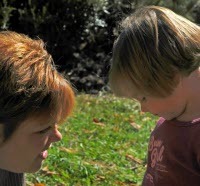
Talking (small talk, emphasis on small) is the socially acceptable way to fill the silence void. We’re conditioned to spew small talk, which has nothing to do with actual conversation.
Conversation requires the willingness to listen carefully, while suspending judgement. If we do not pay attention, we are nothing more than the sum of our pre-judgements—our prejudices.
Actual conversation is a verbal dance, as both parties make a serious attempt to communicate, “This is who and where I am right now.” Conversation is sharing who I am through self-reflection, and listening to what the other person has learned of themselves through their self-reflection.
Many people confuse self-reflection with an endless whine about how tough their life is.
[story in my book, Half Asleep in the Buddha Hall]
Even when you listen carefully, your ego-based prejudices have a way of confusing you. Listen again, with a clear heart and mind, and you might hear something different.
Remember: slow down. Speak your truth, from as deep inside as you can reach. Reveal more and more of you, including the messy, evil, nasty parts. Then, shut up, watch and observe. As you find yourself planning a response to what another is saying (in other words, you have stopped listening,) shut up and open your ears. A conversation is never a debate, and there is no winner.
4. “Slump? I ain’t in no slump. I just ain’t hitting.”
We are nothing more than our self-definition. Or, as the Buddha said,
“All that you are is what you have thought.”
We endlessly self-describe, and because we think it, we tend to stop there, believing we are as we think ourselves to be. Therefore, to change is, first, to change your self-description.
[story in my book, Half Asleep in the Buddha Hall]
Our lives are the proving ground for our beliefs. Where I am in life— right now—is a perfect mirror of who I am, what I believe, and especially what I do. I can look at my surroundings and at my mental, emotional, and physical state and tell precisely what I believe, and who I am.
We need to explore the rules we operate under. If we don’t look at what we believe, to see if what we believe makes sense for us now, we are doomed to live out some old version of our life plan, and be totally miserable in the process.
Remember: “a slump” is a judgement, and makes the thing perceived seem to be something outside of your control. If you put the way you are presently into a box labeled “Out of my control,” you are well and truly screwed. Instead, empty that box. A simple statement of, “Here is where I am right now” allows for the next clause, “…and here is what I will do differently.”
Berra’s “I just ain’t hitting” is actually his way of saying, “I am not hitting right now, and will hit next time I’m up to bat.”
You think it, you are it.
3. “If you come to a fork in the road, take it.”
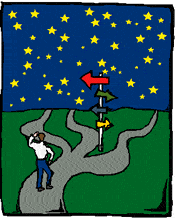
This is opposed to just standing there, staring at the fork, refusing to choose, to move, to decide. Or, you’re going down a road that’s not getting you where you want to go. You come to a place for changing directions, yet continue down the old path. You say, “I may not be getting what I want, but at least this path is familiar.”
Others are stuck in deep inertia, refusing to shift anything, including the painful stuff, until they can be assured that they’ll get to the ‘right’ destination.
Just standing at a crossroads, endlessly debating the ‘right path,’ is a mook’s game. Unfortunately, our world is filled with people doing just that—doing nothing, while bragging about how much effort they are putting into their internal debate.
As they stand there. Doing nothing.
Not to decide is to decide. What happens in our life is about what we notice or give credence to. Something different happens in our lives when we choose to shift our understanding, and then our actions. This way, or that way—no difference, no waiting to identify the ‘right path’—just take the fork in the road.
[story in my book, Half Asleep in the Buddha Hall]
Remember: life presents endless forks in the road. In general, any choice we make can be changed at any time. (Life and death choices occur rarely.) Turning a garden variety choice into life and death (“But… but… what if I make the wrong choice???”) is actually a way to stay stuck. Pick one, and start walking. You do not get the time you waste back at the end of your life.
2. “I never blame myself when I’m not hitting. I just blame the bat, and if it keeps up, I change bats. After all, if I know it isn’t my fault that I’m not hitting, how can I get mad at myself?”
Regret, blaming yourself, getting mad at yourself… a trio of stupidity. What Berra is describing in this quote is so Zen—“This is not working, so let me try this.” His “blaming the bat” strategy is perfect. Blaming the bat is “no-blame,” or non-attachment-to-blame. Berra’s bat was a totem —a symbol—and he used it to re-focus his attention.
Here’s an illustration: say your kid misbehaves, and you decide to yell at her. The kid flinches, cries, and runs and hides. And later repeats the mis-behaviour.
The wise soul “does not get mad at herself.” She looks at the bat she chose—her choice to yell. She “blames the bat,” and picks up another bat—she apologises to her daughter and talks the issue through. Remember: blaming the bat is no-blame!
Non-attachment starts with acceptance that everything is as it is, until it isn’t. When things go ‘ass-over-teakettle,’ it’s essential not to get into blaming or recriminations, as all this does is freeze you in place, without ‘things’ changing.
Being in crisis is the perfect time for a little mantra:
“This is not about me, this is not personal.”
[story in my book, Half Asleep in the Buddha Hall]
In reality, nothing is happening to us.
All one can do, as Berra states, is drop the judgements while doing something new. Blaming yourself accomplishes nothing. Shifting focus helps us to remember that life is endlessly moving on, and we are stepping into it, moment by moment. Nothing ever remains the same.
Remember: when seemingly lost, open your eyes and see the beauty around you, then ski in a logical direction, gracefully and smoothly. Breathe. Watch life continue to unfold. Act, have faith, and detach. You will get home, one way or another. Panic and giving up, although popular, gets you nowhere.
If what you are doing is not working, change bats — no blame, no recrimination. Move. Now.
1. If I didn’t wake up, I’d still be sleeping.
Here’s my favourite image. I think it’s by John Daido Loori.
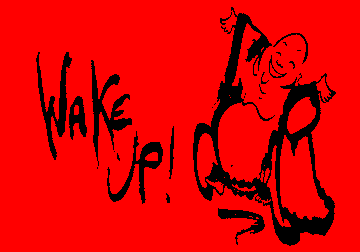
If you are not awake, you are asleep. Period.
Being asleep is the norm in our world. People are caught in dreamscape living, making what little they observe fit their preconceived notions, categorizing people and experiences according to their prejudices.
Being awake is simply being. It starts with a conscious suspension of judgement, through the discipline of directing one’s attention. Judgements fade and what is left is awakened living.
Here is a description of being asleep: as you react out of habit, fear, or confusion, you are drifting off into dreamland.
As I wrote in This Endless Moment:
One point of [the movie] Waking Life is captured in the title: one can choose to wake up to life. Or one can live forever trapped in a dreamscape, living a “life” of “woulda, coulda, shoulda.” In a hundred years, no one will remember your name. No one, ever, will know you. Except, possibly, you. If you choose.
And the only you that you can know is the you that you are in this moment. You are not your past—all you have is a present explanation of the story you tell yourself about what you believe happened to you.
In other words, you experience your past now and only now.
You are nothing more than this moment, this breath. In this moment, you can be fully alive and fully present. And in that choice, you are whole, complete, and without blemish.
Authentic, enlightened humanity exists only in the Eternal Now.
Wake up!
[story in my book, Half Asleep in the Buddha Hall]
Life is about ‘waking up’—about getting on with what needs doing. There are a million and one reasons for not starting, for turning back, for staying put, for being ‘safe.’ At the end of the day, however, nothing will have changed. Far better to risk, to dare, to climb.
Far, far better to ‘wake up’!
If you liked this article, here’s another on Zen Living!
November 17, 2019
What, exactly, is up with love?
The question itself comes from an essential misinterpretation regarding the meaning and purpose of life.

Psst! Hey!
** Want more great writing designed to help YOU to shift your behaviour?
** Want to learn how to find, build or deepen your principal relationship?
** Want to know more about Zen living and being?
The book most closely associated with today’s article is:
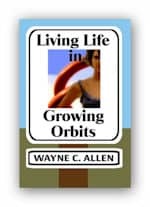
The. Best. Relationship. Ever.
Elegant, Intimate Relating is an art. It requires attention, focus and persistence. My book, The. Best. Relationship. Ever., is packed with guidance, exercises, and directions for drastically improving your relationship.
We’re starting with a quote from
a book by Tom Robbins — Still Life with Woodpacker.
On the fourth day, she decided to think, in an organized manner, about the problem of romance. “When we’re incomplete, we’re always searching for somebody to complete us. When, after a few years or a few months of a relationship, we find that we’re still unfulfilled; we blame our partners and take up with somebody more promising. This can go on and on- series polygamy- until we admit that while a partner can add sweet dimensions to our lives, we, each of us, are responsible for our own fulfillment. Nobody else can provide it for us, and to believe otherwise is to delude ourselves dangerously and to program for eventual failure every relationship we enter. Hey, that’s pretty good. If I had pencil and paper, I’d write that down.” Alas, she had no pencil, while the roll of paper that sat by the chamber pot was destined for a different end.
Next, she thought, “When two people meet and fall in love, there’s a sudden rush of magic. Magic is just naturally present then. We tend to feed on that gratuitous magic without striving to make any more. One day we wake up and find that the magic is gone. We hustle to get it back, but by then it’s usually too late, we’ve used it up. What we have to do is work like hell at making additional magic right from the start. It’s hard work, especially when it seems superfluous or redundant, but if we can remember to do it, we greatly improve our chances of making love stay.” She was unsure if that idea was profound or trite. She was only sure that it mattered.
Tom Robbins, Still Life With Woodpecker, pp. 157–158
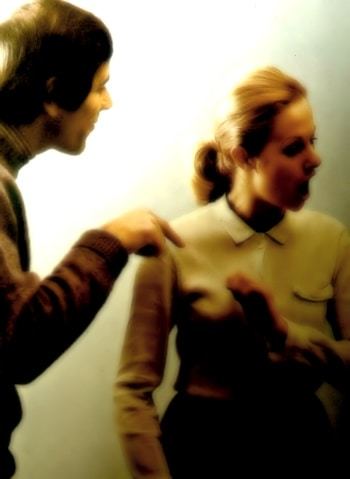 who knows how to make love stay?
who knows how to make love stay?From “Slugcology” and “Music for the Hard of Thinking”
Doug and the Slugs
Who knows how to make love stay?
Help before it gets away.
That’s the question of the day.
Who knows how to make love stay?
The famous Canadian band Doug and the Slugs asked the same musical question that is posed throughout Tom Robbins’ Still Life with Woodpecker. What, exactly, is up with love? With romance? And how, oh how, do we get love to “stay?”
The question itself comes from an essential misinterpretation regarding the meaning and purpose of life.
One answer to the “Meaning Question” is: We are driven by a biological imperative to “fall in love,” and the biological purpose of falling in love is reproduction of our DNA, ala Richard Dawkins in The Selfish Gene.
The initial flush of falling in love is akin to an endorphin rush, and as we know, endorphin is the heroin of hormones. No wonder we feel so flushed and full of beans when we meet someone new.
Although some people would argue that the biological imperative is “all” that life is about, we look at things differently. It’s likely why I like Tom Robbins so much. In each of his books, and in a multitude of different ways, he returns to the same theme — which is our answer to the “Meaning Question” -
“self-development requires self-responsibility.”
Which is the point in the first part of today’s quote. Many people who have relationship issues admit to having pretty much no idea as to why they are in the relationship they are in. They talk about what Robbins calls “magic” — the sappy, simplistic blast of hormonal energy that makes knees weak, stomachs queasy and brains to operate on half cylinders.
I prefer to eliminate the biological imperative from this equation, not because I find it unimportant, but because that’s what everyone does anyway. People seldom complain that their relationship is on the rocks because of reproductive incompatibility. They are considering ending the relationship because the magic died, and they couldn’t get love “to stay.”
In other words, relationships end for
psychological reasons.
A relationship is simply one more arena where we play the only game we ever play — figuring ourselves out. But it is impossible to figure yourself out through a relationship. Thinking you can tends to mean one thing: I now have my partner to blame for my inability to figure myself out.
As Robbins put it:
…we, each of us, are responsible for our own fulfillment. Nobody else can provide it for us, and to believe otherwise is to delude ourselves dangerously and to program for eventual failure every relationship we enter.
My sense is that most people mistakenly enter relationships in an attempt to (over) compensate for their upbringing… or to avoid dealing with their resistance to self-discipline.
It’s not unusual for people to latch on to others to try to work through dysfunctional relationships with their parents. Or, because people sense what a difficult discipline “getting over themselves” entails, they avoid dealing with their issues, neediness and incompleteness by drafting another person to fill the gap.
The intent is to fill in the blanks so that, between two people there is one whole person. Thus the expression, “(S)he makes me feel complete.”
As Robbins writes, love leaves… and the magic dies… at approximately the moment that the first of the two people realize that the other has failed at the task of making them feel better about themselves.
Then, that person starts with the, “How dare (s)he! Doesn’t (s)he know how much energy I’ve put into this relationship?” Rough translation: “I’ve wasted years! Now I have to go out and find someone else to make me better, or make it better for me.”
If, on the other hand, this gets played out another way, in a self-responsible way, then, from the get-go,
I won’t be looking to “be taken care of” or “to be understood” or “to be loved the way I should have been when I was growing up.”
I will have gotten over the need to look outside of myself for someone to blame, or for someone to rescue me.
I will be quite willing to do whatever I have to do to know myself and be responsible for myself. And
I will be responsible for “keeping the magic alive” because I’m the only one who can — I’m the only one who can keep it alive for me.
Robbins: “work like hell”, “it’s hard work.” Indeed. Much easier to look outside and to sigh and wonder when “it’s all going to magically work out.”
Too bad easy doesn’t happen and magic isn’t.
August 5, 2019
On Resisting the Urge to Give Up
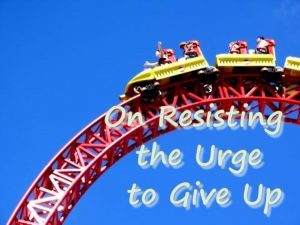
On Resisting the Urge to Give Up — the world we see is the one we get to live in. Choose well how to do so!
TODAY marks the final article in the 20 year run of The Pathless Path.
Back in 2013 I retired, and Darbella an I have been travelling since. I’ve kept up a close to biweekly writing schedule.
I want to thank those of you who have taken the time to write to me. The emails have been wonderful reminders of why I’ve kept writing.
I find it ironic and amusing that the final article is about “Resisting the Urge to Give Up.” I for sure have felt the internal pressure I create for myself … you know .. the voice that says, “Real “men” don’t stop… ever.”
And yet, here we are.
I won’t miss the effort it now takes to write something I deem worthy of your attention. I will miss the sense I get that what I write just might be useful.
Anyway, thanks to those of you who have stuck with me for decades. Your comments and good wishes have quite often made my day.
I wish you all a life on The Pathless Path… in this moment
Warmly, Wayne

Psst! Hey!
** Want more great writing designed to help YOU to shift your behaviour?
** Want to learn how to find, build or deepen your principal relationship?
** Want to know more about Zen living and being?
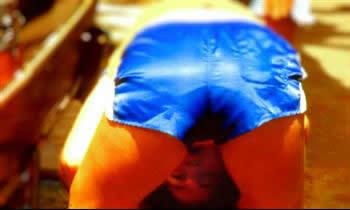 I’m bored! Butt out!!
I’m bored! Butt out!!I suspect that screaming, “I’m bored!” has moved from childhood into what passes for adulthood these days. There seems to be an epidemic of ennui about, as people pretend that it’s OK to watch from the sidelines as the world disintegrates.
As I mentioned last week, I’ve been listening to (and just finished) Tom Robbins’ Even Cowgirls Get the Blues.
One of the characters is “The Chink,” a Japanese anti-guru who lives in the hills near the cowgirls’ ranch. At one point, he’s having a conversation with one of the “girls,” and they’re talking about the state of the world. “The Chink” says that the biggest problem facing humanity is “ambulatory catatonia.”
And doesn’t that just seem to be the case?
This way of seeing things might just have started with the existentialists, who can’t be faulted for noticing the obvious:
Since boredom advances and boredom is the root of all evil, no wonder, then, that the world goes backwards, that evil spreads. This can be traced back to the very beginning of the world. The gods were bored; therefore they created human beings.
Soren Kierkegaard (1813–55), Either/Or, vol. 1, “Rotation of Crops” (1843; tr. 1987).
Kierkegaard, joined by such notables as Nietzsche, Sartre and Camus, began an exploration into meaning vs. meaninglessness. Thus began the modern “noticing” of how fundamentally weird the world is.
By the end of World War II, existentialism was at its height. European existentialists thought that nothing could be any worse than, nor a more clear-cut example of, the meaninglessness of life than the destruction caused by the War. (Little did they know, eh?
French philosopher Jean-Paul Sartre first gave the term existentialism general currency by using it for his own philosophy. Explicitly atheistic and pessimistic, his philosophy declared that human life requires a rational basis but the attempt is a “futile passion.” Nevertheless, he insisted that his view is a form of humanism, emphasizing freedom and responsibility.
The Encarta — Desk Encyclopedia Copyright 1998 Microsoft Corporation. All rights reserved.
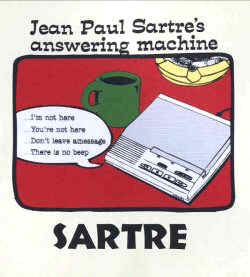
Or, to put it more humorously, this cartoon seems to capture it all: (This cartoon was a part of a t‑shirt collection by a company called Bovis Theads of Kingston, Ont. A web search failed to turn up the company after 1999. They seem to have gone “belly up.”)
The Sartre reference, above, from Encarta, actually contains the seeds of liberation, as noted in the last sentence. Freedom and responsibility is actually the antidote to the stultifying effects of being human.
Thus, existentialism — in its purest form — makes much sense. Note the following definition of existentialism:
A philosophy that emphasizes the uniqueness and isolation of the individual experience in a hostile or indifferent universe, regards human existence as unexplainable, and stresses freedom of choice and responsibility for the consequences of one’s acts.
Excerpted from The American Heritage Dictionary of the English Language, Third Edition Copyright ? 1992 by Houghton Mifflin Company.
As some of you might know, there are parallels to Buddhism here. Buddhism has no interest in the stories we tell ourselves — life just “is” — we just “are,” and the only sane tack is to simply notice then act.
Existentialists (and Buddhists) reject the notion that life is predetermined and run by something (i.e. god) outside of us. In Buddhism, there is endless causation… things emerge out of what comes before… but lack meaning.
In other words, there is NO meaning that is “for all time and for all people.” Instead, we are left with personal understanding (or lack thereof…)
That is, life is “about,” or “means” whatever I choose for it to mean.
We hate this. We want our meaning to be “what everyone means.” So that we don’t feel alone and floating aimlessly in a meaningless universe. This is actually what draws Trump followers in so deeply. It’s the Koolaid of “I’m part of a special group.”
So, how does this relate to ambulatory catatonia, and Resisting the Urge to Give Up?
First, the catatonic among us only “get” the first piece of the existentialist paradox:
…the uniqueness and isolation of the individual experience in a hostile or indifferent universe, regards human existence as unexplainable…
As I just wrote, this idea can be scary — that we are cast adrift, alone, in a little boat on a dark and stormy sea. There is no meaning, no direction and no help from “above.”
Giving this reality, three options exist: fall overboard and drown, stop paddling and tune out (ambulatory catatonia) or enjoy the paddle anyway.
My approach to this existential dilemma is contained in the second part of the definition, above:
…and stresses freedom of choice and responsibility for the consequences of one’s acts.
Many of us, rather than living in the now, sucking the experience out of life, are still stuck in past relationships and situations, as if frozen in motion. We obsess and obsess, and nothing changes, except for one thing: the number of days of your life goes down by one, each day. You don’t get ’em back at the end.
To be self-responsibly free is to let go of attachments to the past. It is to let go of obsessing about the future. It is to find this moment, again and again, and to seize the moment and wring the living out of it, swallowing the moment whole, so to speak.
To do otherwise is to stop in your tracks, and plead for rescue, or to freeze and hope that someone is coming to even the score and level the playing field.
In the mean time, life continues apace, never once looking in your direction nor caring how you are doing.
This week, look at how you are fixed in place, by your assumptions, by your fear, by your lack of courage. Then, decide to experiment with leaving ambulatory catatonia and the dread of meaninglessness behind, and live despite it all.
It’s really the only life there is.
The post On Resisting the Urge to Give Up appeared first on The Pathless Path.
July 19, 2019
Even Cowgirls Get the Blues
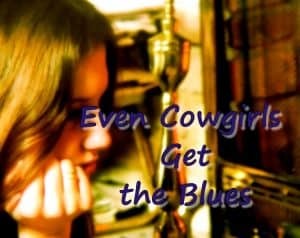
Even Cowgirls Get the Blues — lots of lessons to learn about reality, peace, and understanding
Sooo… 2019 marks the 20th anniversary of this blog. I don’t have the exact start date, but it’s been a journey.
Back in 2013 I retired, and Darbella an I have been travelling since. I’ve kept up a close to biweekly writing schedule.
But now, it’s time to bring The Pathless Path to an end.
This has been a mixed decision, as some of you have been around since the beginning, and many of you are faithful readers.
On the other hand, the well is running dry. I’ve said and re-said what I believe to be so, and nothing convinces me that there is more to like than what you’ll read below. We tell ourselves stories, and that keeps us from being present in the only reality there is.
This moment.
I don’t have an exact “last article date,” but it will be this month or next.
I wish all of you well on your journey into self-responsibility!

Psst! Hey!
** Want more great writing designed to help YOU to shift your behaviour?
** Want to learn how to find, build or deepen your principal relationship?
** Want to know more about Zen living and being?
 You want me to put my thumb where?
You want me to put my thumb where?I’ve been listening to the audio version of Tom Robbins’ Even Cowgirls Get the Blues, and as usual have been enjoying his writing style. One of the characters is a Japanese guru type, called “The Chink.” (Read the book…!) He’s got some interesting things to say, three quotes of which will lead us into today’s discussions. (By the bye, I’m “quoting” out of my memory, having heard the lines, not read them. I expect I’m pretty close but not perfect.)
First quote:
Chink: “Good! You seem much more in balance!”
Sissy: “But one (thumb — again, read the book) is huge and the other is little!”
Chink: “You’re making a common mistake. You’re confusing symmetry with balance.”
Second quote:
The Chink, in discussing religious figures like Jesus and the Buddha, and the perils of organized religion, says something to the effect of:
“The problem with organized religion is that they take the personal and try to make it universal. I’m different. I take the universal and make it personal.”
Third quote: (A “Dr. Robbins” motto)
“I believe everything, and nothing is sacred.
I believe nothing, and everything is sacred.”
That last one ought to be a tee shirt.
I think I’ll start from the middle and work outward…
The flaw of organized anything is captured in the second quote. People work toward understanding the meaning of something — life or work or relationships or communication. “Clever” people develop understandings or systems of explanation, which seem to be based upon a quite practical criterion: “Does what I believe to be so actually work in my life?”
Here’s where the flaw comes in.
A person might come up with a quite workable way of being, and rather than being content with living out their life making elegant use of what they have discovered, they instead invest inordinate energy in trying to get others to “see it their way.”
They, as Robbins writes, attempt to universalize a personal understanding. To this day, most political wars and all religious conflict are based precisely upon this flaw. “If you do not believe what I believe, you are wrong, and therefore deserve death.” As opposed to, “This is how I see it. Isn’t it interesting that you see it differently. Let’s talk.”
Such personal worldviews becomes a struggle for supremacy of ideas and interpretations, as opposed to a discussion about whether and how the different approaches accomplish the task at hand.
The “Chink,” in the book, comes at life from the other perspective. He has realized that, as far as living life goes, pretty much everything we need to know is already known. To try to get everyone to agree that I am so very, very clever, and therefore to adopt my particular slant on how this universal information is packaged seems to me an ego trip of monumental proportions.
Rather, taking all of that information and distilling it down into a personal way of being, seems to me to be the act of a wise soul.
I accomplish much more, personally and professionally, by simply “walking the walk I talk.” This might also be described as leading by example as opposed to griping about others.
Let’s look at the first quote about symmetry and balance.
One of the confusions about balance is the idea that everything and everyone is equal. The point here is “balance” and “equal” are not the same thing. A symmetrical and equal approach is to run around attempting to have clear, present and intimate communication with everyone — friends, co-workers, the grocery clerk, and even expecting this form of communication with people that either don’t know about it or aren’t interested.
Balance, on the other hand, might be recognizing that I can be clear without being intimate, and that it’s only possible to have a truly intimate relationship with one or 2 people. To attempt to do more would pull me out of balance.
Often, to continue this example, we decide, for example, that everyone in our family should want to communicate well. (This would be “personal to universal.”) We then exhaust ourselves trying to force what isn’t into being what is. Balance, in this case, might require a much more flexible, forgiving and radically different approach. It might even include giving others the courtesy and respect to be however they are.
“But… but… I want my relationships to be… well… perfect!!!” Good luck. That would be symmetry. Running from one school of thought to another, for fear of missing something, is symmetry (trying to have everything, just “perfect.”). Learning one thing at a time leads to balance, and eventually, mastery.
The essence of all of this — of both balance and making it personal is captured in the last quote: here we see balance and self-reference in harmony.
People will ask me, for example, if I believe in reincarnation. My typical response is, “I believe in everything. And nothing.” In other words, I understand about reincarnation and resonate with it as a principle, and at the same time have not raised it to “the” principle, or even one I’m particularly interested in. It’s one of many universals that I choose to make personal, not the other way around.
So, we have in this quote a very yin/yang harmony or balance. That which “is” always contains its opposite. To be in balance, I need to believe everything and cling to nothing. I need to see all life and everything as sacred, without making anything into a sacred cow. All that is, simply is.
Living with this approach means I will be willing to try most anything, and see how it goes. I may do something for a while, then stop. I may stop for a while, then restart. I may place my full focus into something, and then shift my focus. What I will not do is stick a toe in, then run scared. I will not say “no” to something just because others disapprove. I will live life whole-heartedly and seriously and deeply, without ever forgetting that it’s pretty much a joke, a tragedy and a fair amount of slapstick.
The goal then, for me, is a continual letting go — letting go of my ego, my need to be right, my need to be in charge of the reality of others. It is a grasping tightly of the truth I know, without the need to make you agree with me about that truth. It’s about “letting you” (non-interference) walk your path, and about amusing myself when you try to make me join you. It’s about the sacredness of life, without forgetting that nothing, no thing is sacred.
In short, it is all about waking up. Me, waking up. Me, waking up me. More on that next week.
And then again, maybe it’s about nothing at all…
The post Even Cowgirls Get the Blues appeared first on The Pathless Path.



